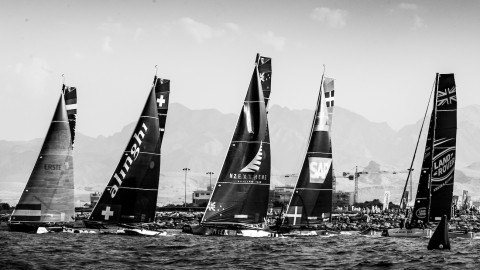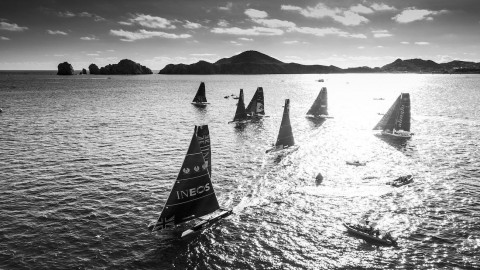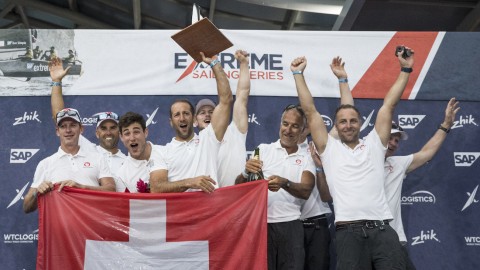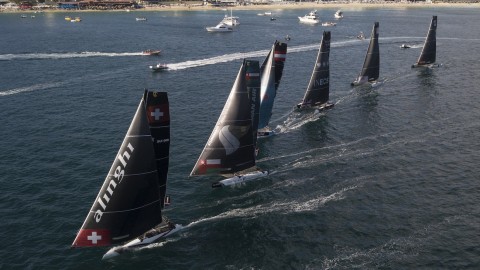The unsung heroes – the Extreme Sailing Series™ shore crew
Racing identical 40-foot catamarans at high speeds in very close proximity to each other on small patches of water can be a recipe for damage, either through wear and tear or in dramatic “slams” or collisions.
Monday 12th January 2015

Repairs for the Oman Air shore crew after the team's crash with GAC Pindar © Xaume Olleros For Red Bull Content Pool
Racing identical 40-foot catamarans at high speeds in very close proximity to each other on small patches of water can be a recipe for damage, either through wear and tear or in dramatic “slams” or collisions.
And that is why a top quality shore crew is such a vital part of any Extreme Sailing Series™ team. They are very much the unsung heroes of the Series who rarely appear on podiums but without whose work – often through the night at race weekends when there has been a big smash – the teams could not function.
The shore crews have a very wide range of responsibility. At the start of an event, it is their job to retrieve their boat from the container in which it has been shipped or trucked from the previous venue. They then have to bolt it all together – the boats come disassembled with the hulls, trampoline and mast having to be put back together each time. They then sort out the rig, put the sails on and service all the moving parts, including the all-important hydraulics that are used to tension the rig, and the winches.
Once the boat is launched and the racing begins, the shore teams double up as RIB drivers helping to ferry guests and crew out to the catamarans before racing. With them they carry a full compliment of spares ready to jump on board at any moment when a boat is damaged or something breaks. And in the event of a capsize, they are the first responders on rescue duty, tasked with ensuring that all the sailors are safe and then retrieving the boat.
One of the biggest jobs for the shore teams is making repairs after a big collision when a catamaran is required back on the water in racing trim the next day. This usually involves an “all-nighter” as the boat-builders replace and patch the broken carbon hull structure and then prepare it for painting in time for the next start.
Jo Lees has been managing the three-man shore team for Oman Sail for the past three years with responsibility for the team’s two boats, Oman Air and The Wave, Muscat. He enjoys the challenge of a unique role where the shore teams in the Extreme Sailing Series function like a Formula One pitcrew, ready to respond to any eventuality. “It’s great fun,” said Lees, a South African with experience in both the America’s Cup and the Volvo Ocean Race. “I grew up playing with boats and, now I am grown up, I am still playing with boats.”
Lees says the key is to be prepared to do almost anything that might be required, from sorting out the boats to the people who sail them. “We are composite engineers, technicians and boat repairers,” he said. “We do a bit of rigging, hydraulics, painting, driving the RIB, making the sandwiches, filling the water bottles and one of the biggest parts of the job is mending the sailors. If they have just had a bad race and need a bit of cheering up or a shoulder to cry on when you come alongside, you’ve got to be that person as well.”
One of Lees’s most challenging days was at the Singapore Act last year (2014) when Rob Greenhalgh on Oman Air was hit in a “tee-bone” collision – when the hulls hit at right angles – by Sir Ben Ainslie’s J.P. Morgan BAR. The incident occurred just after the start of the practice race. As Lees wryly remarks, it made for an “interesting start” to his regatta.
“Obviously we are always prepared for things like this,” he said. “Every time we go out we are expecting something. The first thing you think of is ‘is anybody injured?’ Then it’s a case of saving the boat and stopping water getting into the hulls. So you go straight into emergency mode and straight onto the radio ashore to the crane, making sure they are ready to haul the boat out. The last thing you think is ‘Oh damn! I’m not going to be able to get an early night.’”
On that occasion the impact smashed a hole in Greenhalgh’s boat on the starboard aft quarter, the size of a manhole cover. Lees and his two colleagues worked through the night repairing the hole, then filled and sanded around the repair, making sure it dried properly, then painted it and replaced the lettering on the side of the boat. “The best scenario was we would get the boat out of the water by 4.00pm and get it launched again by lunchtime the next day,” said Lees who has never been confronted by a problem that he has not managed to solve in time for the next day’s racing.
Ian McCabe, his opposite number last year at J.P. Morgan BAR who was also part of the Oman Sail shore team before Lees, says these marathon working sessions through the night are all part of the job and there is no point in the shore crew getting irritated with the sailors for causing the problems in the first place.
“They always look a bit sheepish when they come back to the dock with a big hole in the side of the boat, depending on who’s fault it was,” said McCabe from Warsash on the English south coast. “But obviously they are racing hard on very small patches of water, so collisions are pretty routine for most boats.
“The shore team has to have a good relationship with the sailors because we deliver them a boat that they can go racing on,” he added. “There is no point in being annoyed with them when they come in because they are only doing their job and they rely on us to do our job.”
Some sailors have referred to the Extreme 40s as the nautical equivalent of bumper cars. The shore team managers and boat-builders, like Lees and McCabe, are the people who make that comparison a working reality. “The theory is correct,” joked Lees, “they do smash into each other and most times they are back on the water the next day. But not without anything other than a lot of hard work that night by the shore teams.”
Words by Ed Gorman.




